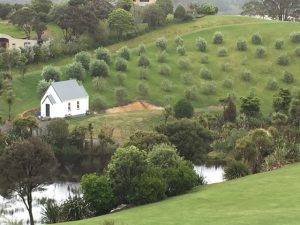
St Francis Xavier Catholic Church – now the Russell Chapel on the Olive Grove – is enjoying a second lease on life.
(Image source Heritage New Zealand)
"A historic Northland church that was deconsecrated and sold to private owners as a result of a dwindling congregation is enjoying a second life.
"St Francis Xavier Catholic Church, originally built in Kawakawa in 1875, was relocated to Uruti Bay near Russell in 2012 by Jo and Ross Blackman, and has been re-purposed as a wedding venue – now known as ‘Russell Chapel on the Olive Grove’.
The Media Release is as follows:
June 9
MEDIA RELEASE
Second life for historic church
A historic Northland church that was deconsecrated and sold to private owners as a result of a dwindling congregation is enjoying a second life.
St Francis Xavier Catholic Church, originally built in Kawakawa in 1875, was relocated to Uruti Bay near Russell in 2012 by Jo and Ross Blackman, and has been re-purposed as a wedding venue – now known as ‘Russell Chapel on the Olive Grove’.
The heritage significance of the church building was recently reviewed by Heritage New Zealand following its relocation from its original site. The review confirmed its heritage importance, and its listing as a Category 2 historic place.
The church had been on Jo and Ross’ radar ever since they began coming up to the Bay of Islands regularly in 1983.
“We were driving up to the Bay of Islands one mid-winter’s day in 2012 and I said to Ross as we drove past it, ‘I wonder what’s happening to the little church now as there doesn’t seem to be much sign of it being used, and it’s looking rather sad and run down,” says Jo.
“I thought it would look stunning sitting among our olive trees on our land at Uruti Bay.”
After a bit of research about ownership, the couple made contact with representatives of the Catholic Church about buying the building, and subsequently Quin Turton of Kawakawa who was acting as caretaker for the building. Quin also provided some information on relocating the church.
“We moved the church on the back of a house moving truck, which we then floated across the Waikare inlet on the Opua car Ferry, and then on by road to Uruti Bay,” says Jo.
“The house movers had carefully sliced the roof off horizontally so it could pass under power lines. We also took the opportunity to replace the bearers and joists before placing it on new piles. Everything below the original floorboards is new, and should be good for another 140 years.”
A final farewell service was held in Kawakawa before it was moved, and another welcome and blessing for the church was held at its new site.
St Francis Xavier Church was used for more than 130 years during its time in Kawakawa and has historical significance reflecting European settlement in Northland in the mid-to-late 19th Century according to Heritage New Zealand’s Northland Manager, Bill Edwards.
“Like many other historic churches in Northland and around the country, falling congregation numbers have raised questions about how viable these buildings are long term. This is an example of an historic church that’s still continuing to serve the community – though in a different guise,” he says.
St Francis Xavier Church was once the religious and social focal point for a large population of Catholic Irish miners who worked in the local coal mines, and who had made Kawakawa their home.
“So strong was the Irish community that the settlement was often called ‘Irishtown’,” says Bill.
Discovered in 1861, Kawakawa’s coal was found to be high quality, and was excellent for both steam and gas making. The town of Kawakawa was built around coal, and in 1868 a rudimentary railway was constructed carrying coal from the mine to the nearby Taumarere Wharf and Landing – the first railway in the North Island.
“With Kawakawa’s rapid population growth there was a growing need for a church to meet the spiritual needs of the people, and in December 1875 the church was built and consecrated,” says Bill.
The Blackman’s have worked to retain the original character and heritage values of the building – including its solid kauri interior – by keeping the interior minimal and letting the building speak for itself.
“The church’s lines are simple and clean and you can almost feel the presence of the Irish miners who built it all those years ago,” says Jo.
“The acoustics are brilliant and we’ve had some wonderful musical gatherings there. The church has also been the focal point of our annual carol singing, which last year drew 120 people. Ross and I both feel extremely happy and very proud to think that our little chapel on the olive grove has a new life and is once more part of the local community.”
According to Bill, it’s generally preferable for historic buildings to remain on their original sites so that they retain their sense of context within a wider heritage landscape.
“In some cases, however, relocation can be an alternative – particularly if it means that there is a danger the building could be lost forever if it isn’t moved,” he says.
“This church was deteriorating on its original site in Kawakawa – and now the building is thriving and making a contribution to the local economy. That’s a good heritage outcome.”












Comments are closed.